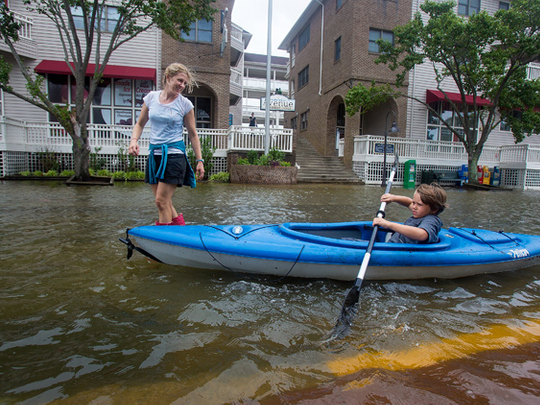
Boston: A weakened but fast-moving Hurricane Arthur swept along southern New England on Friday night, wielding tropical storm-force winds, after an earlier landfall in North Carolina that caused only slight damage.
Powerful wind and heavy rain lashed the Massachusetts summer resort island of Nantucket, a popular destination for visitors over the Fourth of July holiday weekend that was under a tropical storm warning by the US National Hurricane Centre.
Nantucket reported winds of 49 miles per hour (80 kph) gusts as strong as 62 mph (100 kph), the Centre said in a late-night advisory.
A tropical storm warning also was issued for Cape Cod, although it was not being hit as hard as Nantucket.
The centre of the hurricane was offshore about 75 miles southeast of Chatham, Massachusetts, said Jack Beven, a senior hurricane specialist at the Centre.
It was moving northeast at a fairly quick pace but will slow and likely be downgraded to a post-tropical storm system by Saturday, he said.
“The storm is weakening as it moves over cold water,” said Beven. “The storm and the cold are getting tangled together.” The centre of Arthur will pass over western Nova Scotia on Saturday and over the Gulf of St. Lawrence on Saturday night, the National Weather Service said in an advisory.
In Massachusetts on Friday, the storm brought driving rain and caused isolated power outages and flooding.
On Thursday, the famed Boston Pops Fireworks Spectacular, already rescheduled a day early due to the weather, was cut short by heavy rain and lightning.
The first hurricane of the Atlantic season, Arthur cut power to almost 20,000 homes and businesses, downed trees and cut off barrier islands from the mainland after making landfall on North Carolina’s Outer Banks late on Thursday.
State officials said there was minimal damage from the storm. A dozen counties were under states of emergency, and the tourist haven of Ocracoke Island was without power.
“This has been a very good day. There have been no casualties or serious injuries reported,” North Carolina Governor Pat McCrory said at a news conference in Raleigh.
Arthur hit with top sustained winds of 100 mph (160 kph), earning a Category 2 status on the five-step Saffir-Simpson scale. It weakened to a Category 1 as it moved northeast into colder waters of the Atlantic Ocean with 90-mph (145-kph) top sustained winds.
Kathleen O’Neal, owner of Island Artworks on Ocracoke Island, said she could feel her house lift up as the storm passed overhead.
“It was very bad here,” she said, adding that many trees had been knocked down.
Officials on Ocracoke said power could be restored by late on Sunday. A generator was supplying power on a rotating basis.
McCrory’s office said the highway connecting Hatteras Island to the mainland had been blocked but was expected to reopen by late on Sunday.
Arthur was the first hurricane to hit the United States since Superstorm Sandy devastated New York and New Jersey in October 2012, causing an estimated $70 billion in damage.












